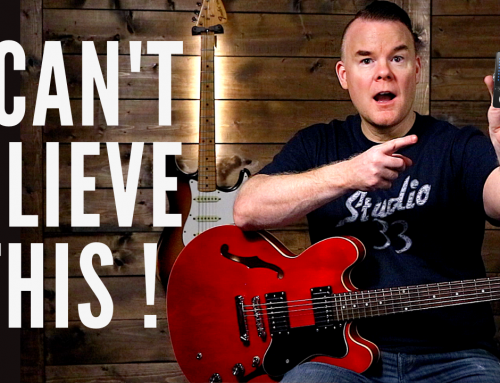HOW TO TUNE A GUITAR
This week’s lesson is How To Tune a Guitar. That might not seem like a very interesting topic, but it’s extremely important, because you can be the best guitar player in the world, but if your guitar is not in tune, it’s not going to sound good.
The video below explains exactly how to tune a guitar, both by ear and by using an electronic tuner.
TUNING BY EAR
Tuning by ear is a very valuable skill, but it is also not an easy one to develop; it takes time and practice just like any other aspect of playing guitar.
When tuning by ear, you must first get one string in tune and then tune the rest of the guitar to match that string. In order to get that first string in tune, you will need some sort of reference note. That can be achieved by playing a note on a piano or other instrument, or by using a tuning fork or pipe, or by finding reference notes online. After you have been playing for a while, your ear will develop and you will be able to estimate the correct pitch of a string. You will then be able to tune the rest of the guitar to match that string. This method works fine if you are playing alone, but if you are playing with another instrument (or a recorded song), you will need to make sure the guitar is in tune with them.
In order to tune the guitar, you need to know what pitch each of the strings should be tuned to. When we talk about the tuning of the guitar, we start with the thickest string and go in order to the thinnest string. “Standard Tuning” is how we describe the way a guitar is normally tuned (certain songs or styles of music may require alternate tunings)
In Standard Tuning, the guitar strings would be tuned as follows (from thickest string to thinnest): E, A, D, G, B, E
That means when the strings are played “open” (without pushing at a specific fret) these are the notes that are produced.
A good way to remember their names is by using some sort of phrase that uses these letters. There are many phrases you could use, but here are a few examples;
Eddie Ate Dynamite, Good Bye Eddie
Eat All Day, Get Big Easily
Elephants And Donkeys Grow Big Ears
THE “FIFTH FRET” METHOD
We usually start with the lowest string, which should be an E note. Again, to tune this first string we will need a reference note to tune to or estimate if you just need the guitar in tune to play by yourself.
Once you are happy with the E string, you will tune the rest of the strings to match it using the “Fifth Fret” method. This method is the most common way to tune a guitar. The fifth fret of each string is the same note as the next open string.
Start with placing your index finger on the 5th fret of the E string and play that note. This will produce an “A” note, now while that note is ringing, play the open “A” string. You will be able to hear if the notes are the same pitch or not. The goal of course is to have those two notes match and be the identical pitch. After you play the two notes together, allow them to continue ringing and reach over with your right hand and start turning the A string tuning key. You will hear the pitch begin to change.
You may also notice a “wobbling” sound as the two notes are played. This is due to the two different frequencies happening at the same time. If you know about sound waves, you know that they have peaks and valleys and depending on the frequency, these peaks and valleys will be different distances apart. When two frequencies are occurring at the same time, the peaks and valleys do not line up, which creates this wobbling sound. As we turn the tuning key and change the frequency of the A string, you will notice they start to get slower and eventually stop as the two frequencies match up. This will take time and practice for your ears to hear this, but it will get easier with repetition.
Once you have the A string in tune with the E string, you follow exactly the same process for the next two strings; to tune the D string, play the 5th fret on the A string (a D note) and tune the open string to that note. To tune the G string, play the 5th fret on the D string (a G note) and tune to that.
Things change slightly for the B string. You need to use the 4th fret on the G string as your reference note, because it is a B note. Once you move on to the high E string, you return to using the 5th fret on the B string.
IMPORTANT POINTS TO REMEMBER
If you are not sure if you should turn the tuning key higher (tighter) or lower (looser), the safe bet is to begin by turning it lower so that you don’t accidentally break a string by over tightening it. If turning it lower makes the notes sound further apart, then you know you are safe to begin tightening the string.
If the note you are tuning is too high and you need to tune down to the correct pitch, always make sure you tune down below the targeted pitch and then tune back up to the correct pitch. This will ensure that the string remains tightly wound around the post. Otherwise, it may loosen as you play and go out of tune.
Please watch the attached video for more info.
Troy (Studio33Guitar)






